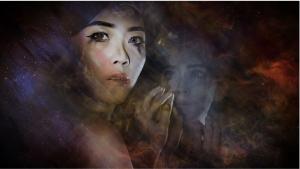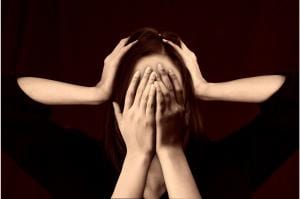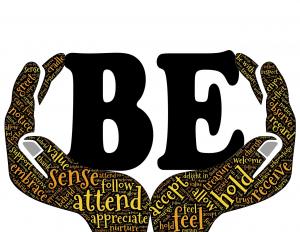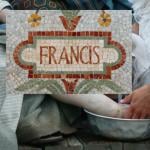“A picture is worth ten thousand words”~ Fred R. Barnard
As I sipped my morning coffee an email caught my eye. Someone had sent me a dream question. “What does it mean if you see yourself in a mirror in your dream?” it read.
“Mirror, Mirror, on the wall” was the first thought that came to my mind.
Like the Jabberwocky in Alice In Wonderland’s Dream, I stepped through my inner Looking Glass to help answer the emailer’s question.
Our dreams are our personal Inner-Speak-Language.
If this mirror dream were my dream I might embrace it as an opportunity for reflection and inner-discovery. “What am I trying to show me.” Although there are words and conversations in our dreams a high percentage of most dreams are visual.
A mirror is visual.
According to current research at UCSC even blind people dream highly visual dreams. The first time the idea of blind people dreaming was brought to my attention was during one of my live radio shows when a young middle-school student called in to ask me if I could help her with a homework project, “to find out if blind people dreamed.” Together we discovered they do indeed dream in pictures that are unique to them; the blind dreamer.
We speak to ourselves using signs, symbols, and pictures that often only have a specific meaning to us.
According to Wikipedia the concept of “A picture is worth a thousand words” is an English language-idiom. It comes from the Chinese saying, “百闻不如一见” It refers to the notion that a complex idea can be conveyed with just a single still image more efficiently than a description.
Further research explained the idea of pictures as communication with the expression, “Use a picture. It’s worth a thousand words.” This appears in a 1911 newspaper article quoting newspaper editor Tess Flanders. Ms. Flanders was discussing journalism and publicity.
Isn’t it amazing how journalism and dreams share pictures to communicate with us?
When we do speak words to ourselves in dreams their meaning and sense can get lost in the translation from our dreaming to waking world. Like the Jabberwocky in Alice in Wonderland’s Dream Scape the words themselves are correct, but upon reflection, do not seem to convey a coherent message
And, that brings us back to visual communication and mirrors because a picture is indeed worth a thousand words.
A picture or reflection means different things to different people because we process and connect with it through personal experience.
Two different people looking at the same picture of a dog may experience two opposite sensations depending on their upbringing, culture, and experience. The first person may feel happy and see love. The second person may feel fear and see a danger. Depending on the culture, a third may see food.
The Universal symbolism for the dog is a companion, guide, and protector.
In the Tarot Card Deck, the Higher Arcana Fool has his loyal dog at his feet as he trusts in his Greater Power and takes a giant leap of faith off the top of the mountain to begin his journey of life.
Now, imagine two people of similar height and weight looking in the same department store mirror to critique the exact same piece of clothing they are both modeling. Do you think they see it exactly the same way and that it will elicit the same emotional response?
So what could “Mirror, Mirror on the wall…” mean in a dream?
A  mirror reflects reality. But here is the challenge; the truth is relative and filled with a play on words, especially in a dream. This is seen in many dream books, as with the research patients in the book Dreams That Can Save Your Life. Many patients in crisis dream of mirrors.
mirror reflects reality. But here is the challenge; the truth is relative and filled with a play on words, especially in a dream. This is seen in many dream books, as with the research patients in the book Dreams That Can Save Your Life. Many patients in crisis dream of mirrors.
If you are going through an illness you may see yourself as healed. If you have an apparent physical ailment that requires a cane, you may see yourself twirling in place crutch free. A mirror can be a glance into the future or the past to find the person you once were or wish to become, or it may afford you the opportunity to, “see yourself coming and going, front and back, head to toe.” It is an incredible opportunity for Mirror Therapy within the Dream-Scape of Dream Therapy.
However, one person’s reality is another person’s imagination. How often have you heard someone say, “No, that is not the way it really happened. It happened like this!”
Are both people wrong? Did they miss the message in the experience? Perhaps, they are both right and the message is a matter of perception.
Like mirrors, Dreams are a reflection of our physical, mental, and emotional reality. And, we may not always agree with ourselves.
A mirror in our dream reflecting ourselves back to us may be an opportunity to “take a closer look” at situations affecting our life. Our perception of ourselves may be different from the perception others have of us. This may be an opportunity to take a personal inventory of our intention, our physical state, or to take a closer look at our inner-selves though the windows of our soul; our eyes.
A mirror also gives us the opportunity to gaze upon perfection directly.
God does not make mistakes, man does. You were made perfect. You are exactly who you are, where you must be at this moment in your life, and cannot be anyone or anywhere else at this time.
The next time you see yourself in a mirror in a dream reach out and touch yourself, gaze upon your perfection, become one with you, and most of all believe in the connection, and you will build belief in yourself.
About the Author: Kathleen (Kat) O’Keefe-Kanavos is a TV Producer/Host and Author/Lecturer of Dreams That Can Save Your Life which promotes patient advocacy and connecting with Dreams for success in health, wealth, and relationships. Contact –Kathleen O’Keefe-Kanavos Website – Inner Guide Facebook – Personal Facebook – Surviving Cancerland Facebook – Wicked Housewives TV Facebook – Wicked Housewives Radio Facebook –Dreams That Can Save Your Life Facebook– Google+ – LinkedIn – Pinterest – Twitter – Youtube– Book
Photo credit:
httpspixabay.comenmirror-surreal-fantasy-magic-free for commercial use digressingme mirror-3155886
httpspixabay.comenspherical-ball-universe-planet- strecosa free for commercial use no attribution required 3140452
Dreams That Can Save Your Life- https://www.amazon.com/Dreams-That-Save-Your-Life/dp/1844097447/ref=tmm_pap_swatch_0?_encoding=UTF8&qid=1517198641&sr=8-1 used with author permission.
httpspixabay.comenwoman-lovely-girl-portrait-eyes-3141448Lightstargod-woman CC)- free for commercial use No Attribution Required
Research:
The expression “Use a picture. It’s worth a thousand words.” appears in a 1911 newspaper article quoting newspaper editor
“Speakers Give Sound Advice”. Syracuse Post Standard. page 18. March 28, 1911.
Jump up^ “One Look Is Worth A Thousand Words”. Piqua Leader-Dispatch. page 2. August 15, 1913.
Dreams That Can Save Your Life- https://www.amazon.com/Dreams-That-Save-Your-Life/dp/1844097447/ref=tmm_pap_swatch_0?_encoding=UTF8&qid=1517198641&sr=8-1
http://www2.ucsc.edu/dreams/FAQ/


















